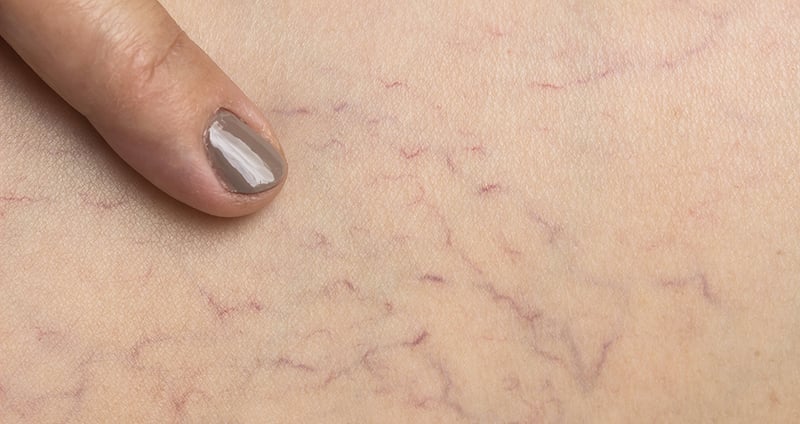One-third of the U.S. population has varicose veins of some kind, including spider veins - thin, wispy veins that are usually most visible across the legs and feet. And if your parents have them, you have a 90% chance of developing them too.
If you spot spider veins on your body, it’s important to take action and notify a doctor. Although spider veins are often purely cosmetic, they can be a symptom of something much deeper.
 Spider vs. Varicose Veins
Spider vs. Varicose Veins
One of the biggest reasons not to ignore spider veins is that it may be difficult for the average person to tell the difference between varicose and spider veins. They’re actually different - spider veins are more cosmetic, and varicose veins can signify a more serious problem in the circulatory system.
Blood Clots
Spider veins can serve as an early warning sign of restricted blood flow issues, like pooling and clotting. Clots are extremely hazardous to the body and can reach the heart, lungs, and brain. Even if that doesn’t occur, over time these problems can cause vein disease, a life-long health issue.
Ulcers
Constant tension within the body’s veins sets the stage for further changes across the body. Spider veins and varicose veins can contribute to inflammation, swelling, and eventually ulcers.
80% of varicose veins are responsible for leg ulcers. In addition, a lack of ability to heal, caused by long-term damage, can result in non-healing ulcers that are a very serious health issue.
Cellulitis
Spider veins can be an early warning sign that other tissue issues could develop, like cellulitis, a skin infection that comes from bacteria that are naturally present on the skin. Cellulitis causes tissue damage, organ damage and ongoing infections that prevent the body from being able to heal.
Thrombophlebitis, Deep Vein Thrombosis and Embolism
When you ignore early symptoms like spider veins, other issues have a chance to take hold. Life-threatening blood clots may develop. Veins may harden and limit blood flow around the body.
- Thrombophlebitis occurs when blood clots up in a varicose vein. The skin becomes painful and warm to the touch. Veins harden.
- Deep vein thrombosis develops in deep veins, where swelling and pain occurs. The legs in particular may be affected.
- Pulmonary embolism happens when a blood clot breaks off and travels to the lungs. It’s a life-threatening condition.
Pain
It can be an extremely painful and life-changing experience to develop the kinds of issues described above. Pain can radiate through the veins, especially down through the legs. Swelling can extend across the body, causing further pain.
Sores and ulcers are also painful side effects of unchecked vein disease. Without a doctor’s care, these open wounds can become quite deep. Even the underlying tissues and muscles can be affected.
What Will a Doctor Do About Spider Veins?
When you make an appointment to have spider veins examined for the first time, several things will happen:
- A doctor will perform a visual examination
- Routine tests, like blood tests, may be performed
- You’ll be asked about your family medical history
- The doctor will check your feet and legs for blood flow and oxygen supply
- Any wounds or skin changes will be examined
- You’ll receive information about spider veins, varicose veins, and related conditions
- You’ll have an opportunity to ask questions and ensure you’re fully informed
- Further tests will be scheduled, if needed
Don’t ignore spider veins. Discuss them with a doctor as soon as possible. At Johnson Memorial Health, we have vein disease experts and a Wound Healing Center to support any vein issues you may have.
